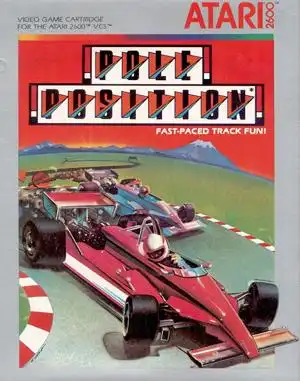Speed, pixelated pavement, and the sheer challenge of not spinning out on a treacherous curve – that's the feeling of firing up Pole Position Atari 2600. While the arcade original was a technological marvel of its time, bringing that experience home to the humble Atari 2600 was a feat in itself. For many retro gamers, this was their first taste of a pseudo-3D racing game, a true classic that still holds a special place in the console's library.
Let's downshift and take a look at what made this version tick and why it remains a nostalgic favorite.
The Arcade Legend vs. The 2600 Port
Pole Position hit arcades in 1982 and was a sensation. It pioneered features like a qualifying lap, a track based on a real circuit (Fuji Speedway), and scaled sprites giving the illusion of depth and speed. It wasn't just about staying on the road; passing opponents was key!
Translating that groundbreaking experience to the less powerful Atari 2600 was never going to be a perfect one-to-one port. Atari licensed the game and tasked its developers with capturing the spirit of the arcade racer within the 2600's limitations. The result is a simplified, yet surprisingly engaging, adaptation.
Gameplay on the 2600: What to Expect
The core loop of Pole Position Atari 2600 remains faithful:
- Qualifying Lap: You get one lap to set your best time. This determines your starting position in the main race. Hit a billboard or spin out, and your time suffers!
- The Race: Compete against computer-controlled opponents over a set number of laps, all while battling a ticking clock.
- Hazards: Watch out for puddles and other cars. Colliding can slow you down or send you spinning. Running off-road significantly reduces your speed. Hit a trackside billboard, and your car is instantly destroyed, costing precious time.
- Controls: You'll use your trusty Atari joystick to steer left and right. The single button is typically used for acceleration (though some versions might have a high/low gear setup).
While the graphics are blockier and the sound effects simpler than the arcade, the fundamental challenge of navigating the track, avoiding obstacles, and managing your time is very much present. It demanded quick reflexes and learning the nuances of the 2600's controls.
Why Pole Position Still Matters on the 2600
Despite its technical compromises compared to its arcade big brother, Pole Position on the 2600 is often cited as one of the better racing games available for the system. Why?
- Playability: It's easy to pick up and play, offering that immediate "one more race" appeal.
- Nostalgia: For a generation, this was Pole Position at home. The distinctive graphics and sounds are burned into the memories of many.
- System Showcase: It pushed the 2600 to render a relatively convincing sense of speed and perspective, standing out among the console's other racers like Enduro, which offered a different, but equally valid, take on the genre.
- Arcade Connection: Even a scaled-down version of such a popular arcade title was a major draw for home console owners.
It captured enough of the arcade magic to be a compelling experience on the hardware it ran on.
Reliving the Race Today
Feeling the need for some retro speed? Playing Pole Position Atari 2600 is still possible today.
- Original Hardware: If you've got a working Atari 2600 console, finding a cartridge is relatively easy through online marketplaces.
- Emulation: The most accessible way is through emulation. Programs like Stella (available for various platforms) perfectly replicate the Atari 2600 experience. You can often find ROMs available legally for games no longer commercially sold on sites like the Internet Archive (archive.org).
However you choose to play, the simple, challenging fun of navigating that pixelated track awaits.
Quick Lap: FAQ
- Is the Atari 2600 version exactly like the arcade? No, it's a simplified port. The graphics, sound, and control nuances are different due to the 2600's hardware limitations, but it captures the core gameplay loop of qualifying and racing against time and opponents.
- Is Pole Position on the 2600 hard to play? It can be challenging! The controls require practice, and avoiding collisions and staying on the track, especially at higher speeds or later in the race, takes skill and quick reflexes.
- Is it worth playing today? Absolutely, especially if you have an interest in retro gaming history or nostalgia for the Atari era. It's a foundational console racer and a great example of how developers brought complex arcade experiences home.
Conclusion
Pole Position on the Atari 2600 might not have had the flash of its arcade counterpart, but it delivered a solid, memorable racing experience that defined the genre for many early console owners. It's a testament to creative programming on limited hardware and a reminder of simpler times when pixelated cars speeding down a striped road felt like the future. So, grab your joystick, hit the gas, and see if you can qualify for the front row!


